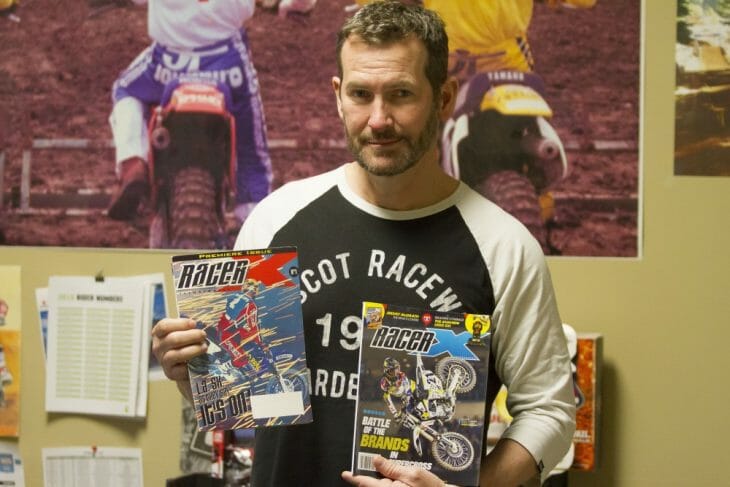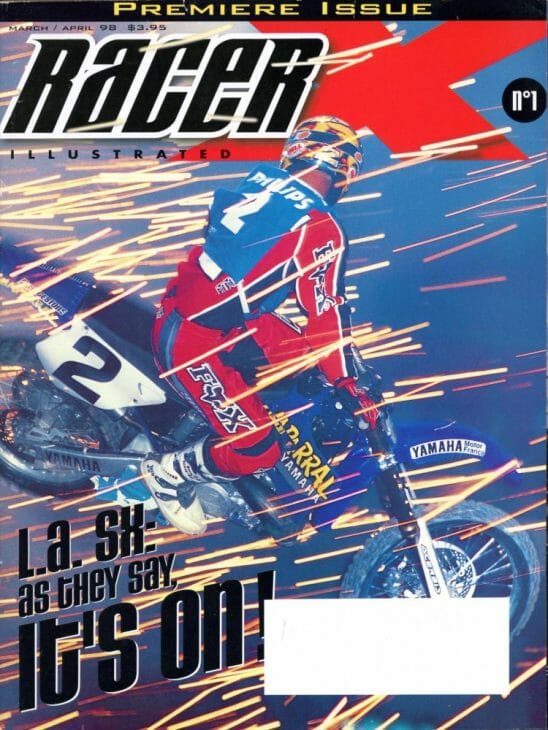Larry Lawrence | March 14, 2018
Archives: Racer X Turns 20
He’d had a successful amateur career and now promising young motocross racer Davey Coombs was primed and ready to launch his pro career in the Daytona 125 East Supercross race. When the race was over the results weren’t quite what Coombs had hoped.
 Davey Coombs holds up the first issue and most recent issue of Racer X, which has published now for 20 years.
Davey Coombs holds up the first issue and most recent issue of Racer X, which has published now for 20 years.
“At that point I thought going to college sounded like a good idea,” Coombs recalls with a chuckle in his voice. “I finished ninth. That turned out to be the high-water mark in my pro career.”
So, it was back to school for Coombs, but along the way he discovered he enjoyed writing about racing. And as they say, one thing led to another and in March of 1998 Coombs launched the magazine Racer X Illustrated. As anyone who even has a passing interest in motocross and Supercross racing, Racer X went on to be wildly popular and established a whole new category in the sport as a lifestyle magazine. Racer X didn’t so much cover racing, instead focusing on the lifestyle the racers and people in the industry led. Sometimes it looked like a glamorized version of the off-track lifestyle of a Jeremy McGrath, Travis Pastrana or Jeff Emig, but Racer X established its chops by not shying away from the often-ignored part of racing, by also telling the stories of the guys who didn’t quite make it or who fell from grace in an equally compelling manner.
This month Racer X turns 20.
“We didn’t make a big deal of it,” Coombs says. “We think we’re still kids.”
Coombs mentioned a special 200th issue of Racer X (Feb. 2016 edition) where they looked back at the first issue in comparison to today’s magazine. It illustrated how quickly things can change in the rapidly-moving world of motocross.
“There were some things we saw coming and others we didn’t see coming,” Coombs says. “As an example, there’s not a single mention of an energy drink in that first issue. There’s just one photo of a four-stroke.”
When he looks back on it now, Coombs said the transformative moment for him was when he realized he liked writing about and photographing racing as much as he did participating in the sport as a rider.
“I really liked telling stories and going on road trips,” he recalls. “So, I starting writing for Cycle News, Dirt Rider, I did a lot of ATV stuff because those were the only people who would publish me. I sort of had a running feud with Motocross Action because Jody (Weisel) and my dad didn’t get along then. Of course, Cycle News was always looking for race coverage, so I’d raise my hand and go cover races no one else would, like a GNCC, an amateur race or a national enduro – anything that I could make 75 bucks off of.”
At the same time the Coombs family business was putting on motocross events. Davey convinced his dad – the late great race promoter Dave Coombs – to let him sell programs.
“I went from selling programs to producing them,” Davey says. “Pretty soon I was in the program business. That was doing well and I thought that maybe I should start a newspaper. There really wasn’t an outlet to write about road trips or forgotten heroes. I mean what publication could you find that would be interested in publishing entire page about the Nac Nac? Cycle News was heavily blow-by-blow race coverage and the existing magazines were into bike tests and product evaluation and I didn’t want to do any of that. I wanted to be like, ‘Hey, we get to go to the dirt bike race this weekend. How great is this?”
At first Coombs produced a newspaper called The Racing Paper for AMA District 5 and it grew. “I would take sacks of them with me when I would go to cover a race for Cycle News. And then I got the job with ESPN and that opened a lot of doors for me. The newspaper became a mash-up of motocross, supercross, off-road racing and all the stuff I wanted to write about that I couldn’t sell to other magazines.”
By 1997 his little newspaper had grown to the point that Coombs felt the time was right to make the leap into the glossy magazine format. He had been inspired by a short-lived, but influential publication titled Inside Motocross, which published for only one year in 1993. Coombs had the concept in his mind, but that jump to a glossy was going to cost serious money. Coombs’ mom and dad (Dave and Rita) encouraged Davey to develop a business plan and take it around the industry to see if he could get backers. He clicked off all the big players in the industry of the time, and while some loved his concept, no one was willing to front the money needed to get the magazine off the ground.
Archives: Racer X Turns 20
 This is the premier issue of Racer X, which turned 20 years old this month.
This is the premier issue of Racer X, which turned 20 years old this month.
“After I talked to everyone and they all said no, my dad said, ‘OK, now that I see how badly you want this, I’ll loan you the money.’ I’m proud to say I paid it back in six months.”
The timing couldn’t have been better and Racer X was a success right out of the gate.
“The industry was really hungry for what we produced,” Coombs explains. “You have to remember the context of where we were. Freestyle was just coming online, the X Games, the Crusty Demons and Terrafirma in the video world were opening up new worlds. This was the after-party era, the Showtime era. People didn’t want to know just who won the race, they wanted to know what they were eating on the way to the race, or what they were doing after the race, or who was the wild man in the group. And you had these ready-made characters like Jeremy McGrath, Jeff Emig, Travis Pastrana and Doug Henry. Guys who just had really compelling stories and who were also very open to the idea of not just being a cookie cutter personality that read sponsors off his fender when he was on the podium.”
And how could we forget the gorgeous girls in the pages of the early years?
The concept was gold. Racer X quickly became the thickest book in the industry. Not only was the look with impactful photography and attractive models, Racer X also boasted some of the best journalist and writers in the industry, telling some of the best untold stories. The company was also on the leading edge when it came to producing websites with exciting content and also were early adopters to social media, which gave them the jump on their competition.
Not that there haven’t been missteps. Davey points to Road Racer X and Racer X Canada as great concepts, but both ultimately had to be shuttered for different reasons. But in the big picture Racer X weathered downturns and became more than a magazine, but rather one of the iconic brands in all of motorcycling.
Coombs says he has no crystal ball when it comes to predicting the future of print publications in the motorcycling industry.
“If I had the ability to see into the future that would be a good thing, but it also might be a frightening thing. I’ve always been the guy who walks out of Barnes & Nobles with two bags or enjoyed the time in front of a newsstand devouring periodicals as much as anyone, but I know that’s a dying breed. But I hope that there will always be a tangible market for some magazines, that people still want to have that thing on the coffee table or in the bathroom or on the airplane, but it’s changing and we’re just trying to cover all the bases that exist right now.”